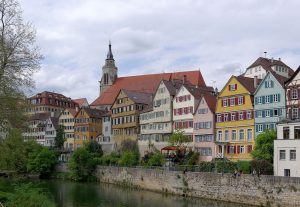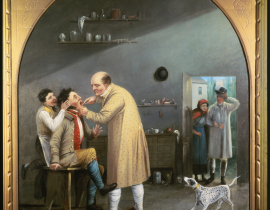Dickens and Germany, Germany and Dickens
This post has been contributed by Katherine Kim.
 In July and August of 2018, the Dickens Society Symposium was held for the first time in Germany. As Natalie J. McKnight noted in her remarks on the first day of the event, Charles Dickens in fact never visited Germany. Thus, the choice to hold the event in Tübingen could be seen by some people as a bit odd. However, as some symposium participants showed, there are connections linking Dickens and Germany and strong interest in the British author in the symposium’s host university town. For instance, Bethan Carney’s symposium presentation was titled “The Ghosts of Christmas Carols Past: The Influence of German Märchen on A Christmas Carol.” Additionally, several Tübingen University students created an exhibition poster on Dickens’s reception in Germany.
In July and August of 2018, the Dickens Society Symposium was held for the first time in Germany. As Natalie J. McKnight noted in her remarks on the first day of the event, Charles Dickens in fact never visited Germany. Thus, the choice to hold the event in Tübingen could be seen by some people as a bit odd. However, as some symposium participants showed, there are connections linking Dickens and Germany and strong interest in the British author in the symposium’s host university town. For instance, Bethan Carney’s symposium presentation was titled “The Ghosts of Christmas Carols Past: The Influence of German Märchen on A Christmas Carol.” Additionally, several Tübingen University students created an exhibition poster on Dickens’s reception in Germany.
Although admittedly not vast, there exists some scholarship on Dickens and Germany. One early work by E. N. Gummer comments on members of Dickens’s family who visited Germany, the reception of the author’s work in the country, and some references to Germany and German culture in various Dickens publications. For the 1970 centenary of Dickens’s death, L. H. C. Thomas examined nineteenth-century German writer and Shakespearean critic Otto Ludwig’s untranslated readings of several of Dickens’s works, claiming that they “[have] the advantage of deriving from an impartial observer, unoffended by detail which may have seemed like a personal attack to some English readers of that age, uninvolved in the social and political points at issue, judging the novels solely from an aesthetic standpoint as examples of narrative fiction” (48). Among more recent scholarship, Antje Anderson, Norbert Lennartz, Stefan Welz, and Joachim Möller discuss Dickens and Germany in Michael Hollington’s The Reception of Charles Dickens in Europe.
Gummer and Anderson have noted that the relationship between Dickens and Germany was one that began early in the author’s career with translations of The Pickwick Papers and that reached its height with David Copperfield. The popularity of translated texts in German-speaking regions (mostly of works originally in English or French) extended to Dickens’s fiction despite (or perhaps because of) a reduction of “alterity, or foreignness, of Dickens’s novels for a German audience” (Anderson 20-22). In fact, Dickens’s writing took the place of Sir Walter Scott’s as a literary model for German writers, one that provided insight into the likewise lauded social model of Britain. As the nineteenth century continued, however, Dickens’s popularity in both Britain and Germany decreased, and German writers and critics came to view German Idealism as superior to the “English materialism” perceived in Dickens’s fiction (31).
While critical and mainstream admiration of Dickens’s writings waxed and waned in the German-speaking world during the author’s lifetime, Dickens’s knowledge of German writings and culture seems never to have been extensive. Dickens could neither speak nor read German, and his library collection of German editions of his writings was relatively small (Gummer 241). Nevertheless, several times he wrote in letters about his deep regret about never learning German (240). In addition, he saw to it that his eldest son received an education at Leipzig by seeking the aid of his friend (and a publisher of his works) in Germany, Christian Bernhard Tauchnitz (Dickens’s children Francis and Kate also visited Germany in the 1860s) (Forster 570 & Gummer 243).
References to Germany in Dickens’s works, although not copious, do appear regularly. For example, The Pickwick Papers, Nicholas Nickleby, and Little Dorrit contain German characters. Cousin Feenix of Dombey and Son lived for a while at Baden-Baden, and Mr. Skimpole of Bleak House sings German drinking songs. The piece “A Christmas Tree” calls the holiday decoration “that pretty German toy,” and in Our Mutual Friend Silas Wegg is described as looking like a “German wooden toy” (Gummer 243). In The Uncommercial Traveller, there are several references to Germany and German objects, such as the “travelling chariot” “of German make” (Dickens 85). While not all references to Germany, German people, or German objects may seem essential to the plots of Dickens’s works, they contribute to the vibrant narratives that Dickens created and was alternately praised and criticized for during and after his lifetime.
Early twentieth-century criticism and general European interest in Dickens’s works continued the downward trend that was evident in the second half of the nineteenth century as aesthetic tastes changed and the author was viewed as “an anti-decadent optimist and humorist who conjures up past worlds of serenity and defies the Naturalists’ gloom” (Lennartz 37). Yet as some critics promoted views of Dickens’s writings as lacking “courage to show problems as they really are,” a few presented contrasting and sometimes fascinating perspectives (39). For instance, one significant work by German philosopher Theodor Adorno presented a reading of The Old Curiosity Shop which gestured towards thing theory and read the novel as darker and more complex than previous scholarship had predominantly viewed it (39).
Despite waning scholarly interest in Dickens at the end of the nineteenth century, his novels were still popular enough in the twentieth century to the extent that even during the time of Nazi censorship, some of them, including David Copperfield, A Tale of Two Cities, and The Pickwick Papers, continued to be published (Welz 51). Norbert Lennartz claims that the continuous publication and reading of Dickens’s works even through this period could indicate that “in the context of Third Reich universities, the discovery of Dickens as a Modernist was obstructed, and academics less inclined to follow Adorno’s ideas than to regard the author of the Christmas Carol as a writer of shallow popular culture” (44-5). In a way, then, the predominant critical view of Dickens as a writer lacking complexity and revolutionary views in favor of cozy and optimistic depictions helped to continue the author’s readership.
In postwar Germany, with the country’s people lacking food and medicine and its publishing houses under the control of Allied authorities in order to prevent a resurgence of Nazi ideology, the publishing industry encountered more transformation (Welz 52). Still, Dickens’s presence continued to be felt, and perhaps augmented, due to positive perceptions of the writer and his works. Stefan Welz notes that Dickens’s reputation as a model of Englishness was “a popular corrective against any kind of Anglophobia stirred up by the Nazis. Moreover, the very person of Dickens stands for a time of cultural exchange between the two countries since he maintained a close personal relationship with … Tauchnitz” (53). The rise in the quantity and quality of scholarship on Dickens published in English during the 1950s and 60s was followed by such an increase in works on the author written in German, especially in West Germany around the time of the centenary of Dickens’s death (64).
Today, there are more recent traces of interest in (and fondness for) Dickens in Germany not just through critical works by scholars of the country, but also in some quite surprising areas and ways. For instance, the MS Charles Dickens, a cruise ship that frequently sails the Rhine River and stops at ports in Mainz and Cologne, contains Dickens-themed rooms and the three decks Oliver Twist, Copperfield, and Nickleby (“Ships”). In addition, a Berlin elementary school named after “the famous author and philanthropist” was established in 1971 (on the street Dickensweg) and boasts “a well-stocked English-German library” (Charles-Dickens-Primary-School). While the use of Dickens’s name in these manners sometimes may seem exploitative, the fact that a vessel drifting down the Rhine, an educational institution in Berlin, and hundreds of books in English and in translation can be found in German bookstores such as the many in Tübingen at the very least attest to Dickens’s enduring name and presence in a country that he never visited but sent his children to and referenced in a number of his writings.
Works Cited
Anderson, Antje. “Dickens in Germany: The Nineteenth Century.” The Reception of Charles Dickens in Europe, edited by Michael Hollington, vol. 1, Bloomsbury, 2013, pp. 19-34.
Charles-Dickens-Primary-School Berlin. Charles Dickens Grundschule Berlin, https://www.charles-dickens-grundschule.de/en/. Accessed 1 Jun. 2018.
Dickens, Charles. “The Uncommercial Traveller.” Dickens’ Journalism: ‘The Uncommercial Traveller’ and Other Papers 1859-70, edited by Michael Slater and John Drew, Orion, 2000, pp. 83-96.
Gummer, E. N. “Dickens and Germany.” The Modern Language Review, vol. 33, no. 2, 1938, pp. 240-247.
Lennartz, Norbert. “The Reception of Dickens in Germany, 1900-45.” The Reception of Charles Dickens in Europe, edited by Michael Hollington, vol. 1, Bloomsbury, 2013, pp. 35-50.
“Ships > Charles Dickens.” Select Voyages, 2018, http://www.select-voyages.com/ships/charles-dickens/. Accessed 1 Jun. 2018.
Thomas, L. H. C. “Otto Ludwig and Charles Dickens: A German Reading of Great Expectations and Other Novels.” Hermathena, no. 111, 1971, pp. 35-50.
Welz, Stefan. “Dickens’s Reception in Germany after 1945.” The Reception of Charles Dickens in Europe, edited by Michael Hollington, vol. 1, Bloomsbury, 2013, pp. 51-68.


